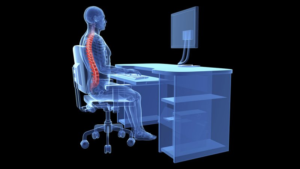Related Courses
Display screen equipment (DSE) is equipment with a graphic or alphanumeric display screen, e.g. PCs, laptops, smartphones and tablets. Regular use of DSE has been linked with the development of a number of health problems, the most common being musculoskeletal problems, headaches and eye fatigue. These consequences are not inevitable and in fact they are often multifactorial, meaning DSE is not entirely to blame for their development. However, there are some simple changes that you can make to reduce your risk of DSE-related health problems.
The main health risks of using display screen equipment are:
– Musculoskeletal problems
– Headaches
– Eye fatigue
Let’s look at each of these risks in details, to explore the most common complications, what causes them and what you can do to avoid them.
Musculoskeletal Problems
Musculoskeletal issues involve the muscles and bones as well as any supporting structures. These commonly affect the arm, neck and back and can be largely attributed to bad posture, incorrect seat set up and incorrect workstation arrangement. The first step in combatting musculoskeletal problems is properly setting up your workstation. Your chair should be at a height that allows your knees to be in line with or lower than your hips, whilst your feet planted comfortably on the ground and your back straight. You should sit upright and your chair should support both your lower and upper back. It is important that your screen and keyboard are placed directly in front of you, with your mouse just beside your keyboard. Your forearms should be kept horizontal and your elbows hung at your sides when typing. Furthermore, your keyboard should be far enough away that your wrists are able to rest comfortably on your desk when you are not typing. Aches and twinges can indicate that you are developing a musculoskeletal problem, so you should act on these by ensuring your equipment is properly arranged.

Headaches
Headaches can be caused by sustained close proximity to display screens, screen glare and inadequate screen contrast and brightness settings. In order to reduce the number and intensity of headaches you have when using DSE, you should position your screen at an arm’s length from you. It is also important to reduce screen glare by using window blinds and adjusting the angle of your monitor. Additionally, you should take care to adjust your monitor’s contrast and brightness levels to suit your current environment (this may need adjusting from day to day). An uncomfortable workstation can result in stress and tension, both of which can culminate in headaches.
Eye Fatigue
Eye fatigue (which just means tired eyes) is a complication of regularly using DSE. Similarly to the causes of DSE-related headaches, having your screen too close to you or with incorrect contrast and brightness settings can cause eye fatigue. As well as properly positioning your screen and updating its contrast and brightness settings, looking away from your screen regularly helps to prevent eye fatigue. Whilst DSE use has not been linked to a deterioration in eyesight, employers are obliged by law to offer DSE users an eye test when requested. This can either be through issuing an eye care voucher or by arranging a test through a workplace healthcare scheme. Similarly, if you are prescribed glasses specifically for DSE use, your employer must provide you with a basic pair of glasses.
How Can I Look After my Health when Using Display Screen Equipment?
As well as incorporating the aforementioned adaptations, there are a number of changes that you can fit into your day to avoid the negative repercussions of DSE use. It is advised that you organise your day to allow at least 5 minutes each hour for non-DSE tasks. This could be things like meetings, phone calls or photocopying. There are also a number of different stretches that you can do at your workstation in order to prevent DSE complications. However, one of the most valuable tools for preventing DSE health problems is display screen equipment training. This will help you understand and account for the risks of using DSE, enabling you to best look after your health.


